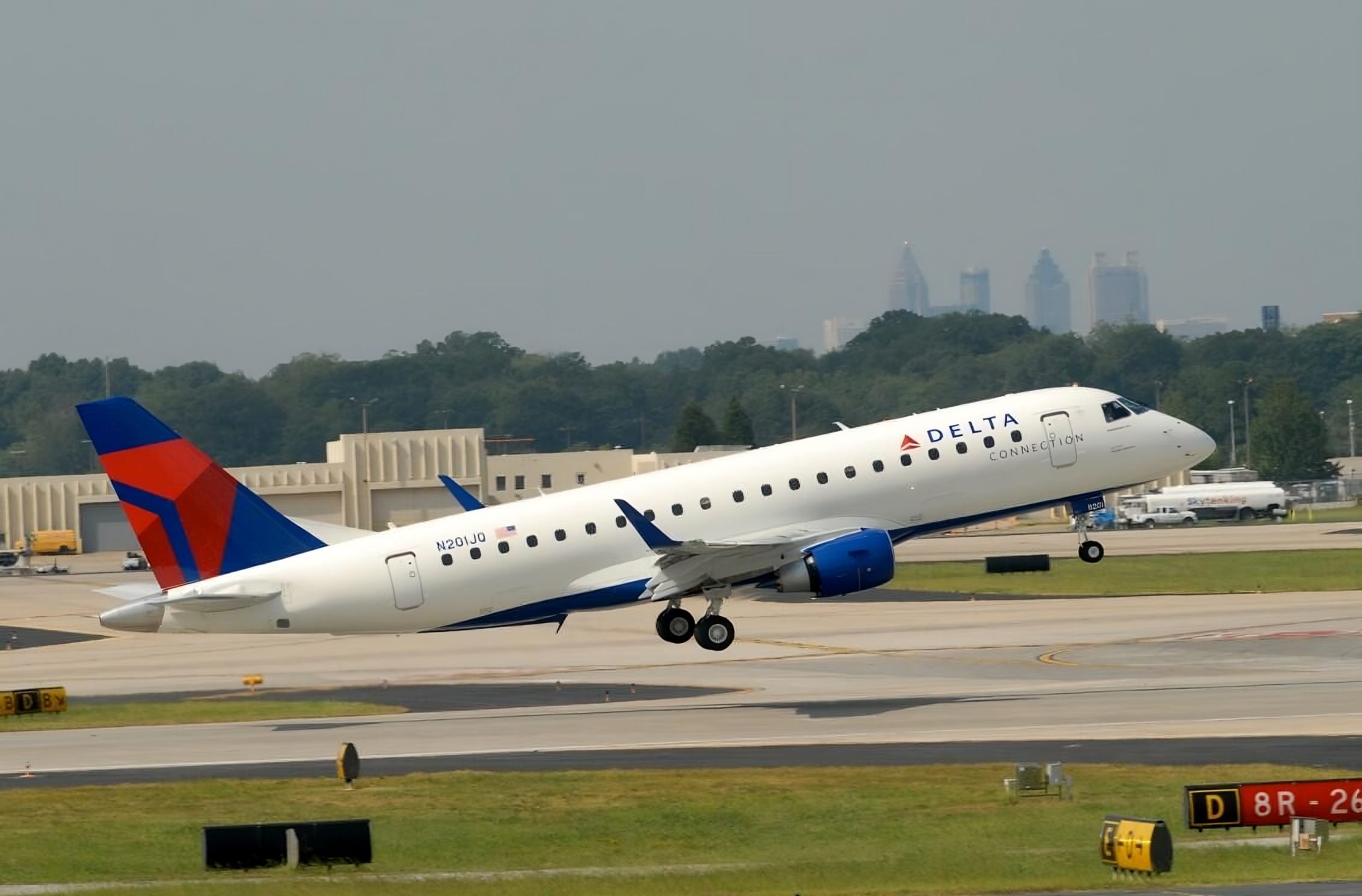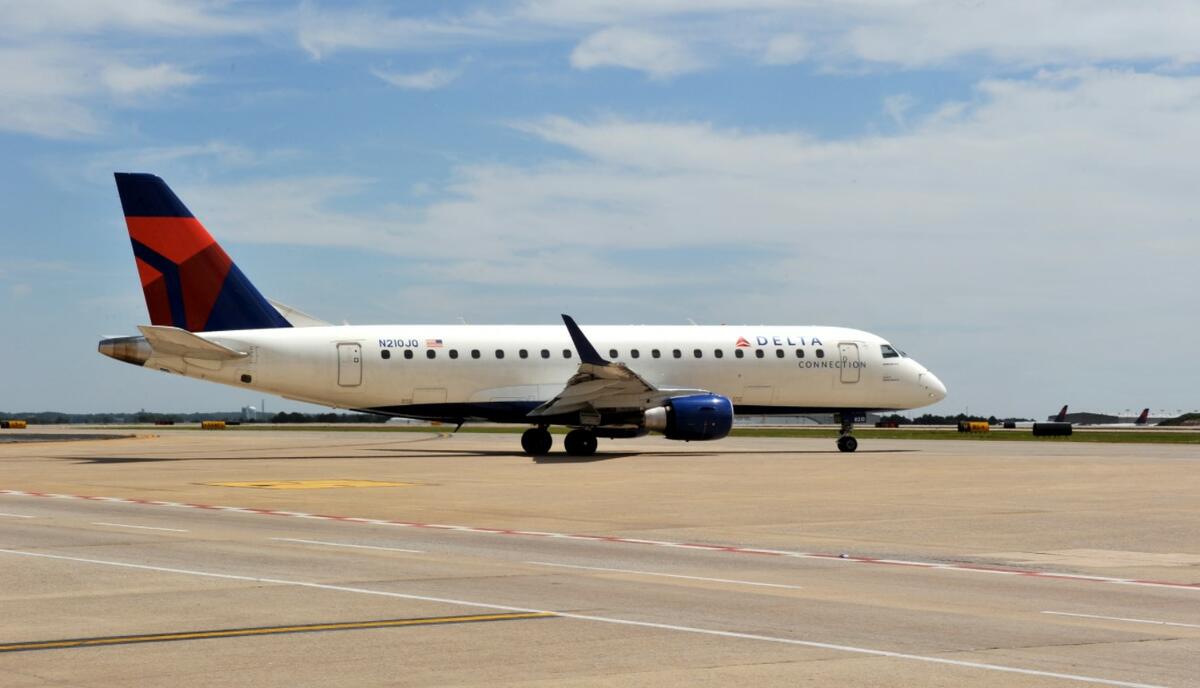Delta Air Lines flight 3788, an Embraer E-175 operated by SkyWest, nearly collided with another aircraft as it flew from Minneapolis–St. Paul to Minot, North Dakota
In addition to operating as a civilian airport, Minot is home to an Air Force base where the 5th Bomb Wing’s 26 B-52 Stratofortress bombers are based.
The Delta Connection flight began its descent toward Minot, and the plane suddenly performed an evasive maneuver to avoid another aircraft converging on their flight path.
As relayed in video recorded by a passenger, the captain came on the PA to explain what happened. He apologized and detailed the abrupt turn to avoid a potential mid-air collision, “For those of you on the right-hand side, you probably saw the airplane kind of coming at us… nobody told us about it.”
@azamora616 #plane#nearmiss#flight3788 @delta ♬ original sound – Andrea
No traffic alert had been given prior to the sighting. He explained that Minot’s airport tower does not have radar, and local controllers rely on visual separation for approaching aircraft. They receive inbound position reports controllers handing off aircraft, and sequences them using pilot reports.
The Minot controller instructed the flight to turn right to increase spacing with another aircraft on approach. The captain spotted an aircraft off to the right side of the jet, reported it to air traffic control, and the controller urgently reversed their instructions telling him “Turn left.”
They banked hard to avoid the oncoming traffic, and those on the right side of the aircraft could actually see the other aircraft “coming at us” in the pilot’s words.
That plane was “a lot faster than us” and on a collision course. The captain initially thought it was a light aircraft, but its high speed made him realize that “it was military” calling what happpened “not normal at all” and suggested it was a B-52.
I don’t know why they didn’t give us a heads up because the Air Force base does have radar, and nobody said, ‘Hey, there’s also a B-52 in the pattern.

Ultimately the SkyWest pilot called it “not a fun day at work.” Passengers broke into applause.
The SkyWest captain’s account clearly implicates a U.S. Air Force B-52H Stratofortress, and Minot Air Force Base’s B-52s often fly training patterns in the area, and a heavy bomber (with its transponder possibly not squawking on civilian systems) could have been performing approaches or departing the base around the same time.
Military aircraft operating with discrete or no ADS-B output will not show up on public flight trackers, nor automatically alert civilian air traffic control. At the same time, the pilot initially thought it was a light aircraft and ADS-B Exchange for the time of the incident shows another plane broadcasting nearby – a small Canadian-registered Glasair III climbing through roughly the same altitude and headed southeast.
The implication was that this Glasair might have been the “airplane coming at us” initially seen by the E-175 crew. So there’s speculation that the near-miss was actually with the small plane – or that two conflicts were unfolding almost simultaneously.
It’s possible that the SkyWest crew and Minot Tower were aware of the outbound Glasair (hence the initial instruction to turn right for spacing behind it), but then the real danger came from the unseen B-52 crossing their path, prompting the hard-left turn.

Thankfully, no collision occurred and the SkyWest E-175 landed safely at Minot shortly after the incident. And the unusually candid explanation from the cockpit was clearly appreciated by passengers (as well as the sharp, alert flying!).


Seems like they should have radar.
Glad everyone’s alright. At least they were “clean on OPSEC…” *face palm*
Here we go again, military aircraft hot-dogging, flying without transponders and cutting across commercial flight paths. Could have easily been another Washington DC mid-air collision.
A large portion of the route crosses Devil’s Lake East Military Operations Area. Civilian aircraft flying through MOAs are supposed to inform ATC of their presence and request permission to enter so the military is supposed to know what civilian aircraft are in the area….yeah, supposed to.
@Doc423 — Asking for a few of our occasional commenters who can’t understand that accidents do happen and that it isn’t usually because of the background or identity of the pilots, do you think would it matter if any of these pilots were say… young, women, or homosexual? Because, personally, I think, if they are ‘fit to fly,’ I don’t care what gender, creed or predilection they have. As Anatoly Dyatlov’s character in the critically acclaimed HBO miniseries Chernobyl says: “Safety first. Always…”
I’d like an explanation as to why military flights do not have active ADS-B during training flights. I can easily understand why it would be turned off during operational flights, but this wasn’t such a flight. There is a long history of military and commercial aircraft collisions, all easily avoidable given today’s technology.
@Ron — Perhaps, these days, we’re more focused on ‘the enemy within’ and the so-called ‘homegrowns,’ so keep those ADS-Bs off in case… antifa or whatever. Psh. All kidding aside, you’re absolutely right, sir. *salute*
Oh SH#T
Maybe we will get an explanation from the military about what equipment they don’t put on military aircraft designed to penetrate opposing countries and survive. Maybe they will even give an explanation why. Don’t bet on it. In fact, bet against it.
Scary stuff, glad crisis was averted and props to the pilot.
1990: Are you on your meds today? Nobody said anything about what you are going on about. Seems like you are a one person show bringing up exactly what you’re arguing against.
@Tim Dunn – Aircraft operating under IFR flight rules (all airline traffic) do not have to announce their presence in an MOA as they are already under ATC control. If the area is “hot” the controller can vector the aircraft to a “safe” location. More troubling is why the B-52 had his transponder off on a training flight, disabling TCAS in the Delta cockpit.
The fact that a military base and a civilian airport share the airfield, but their atcs don’t share information is bad enough. But to me, the really damning thing here is that it was the slower civilian aircraft that had to take evasive action. Wtf were the military pilot and instructor thinking? Faster aircraft has the responsibility to avoid.
Keep climing Delta, unless air traffic control tells you to immediately turn left or right to avoid a mid air collision.
So, nothing really happened other than a regional crew leaving brown marks on their seat cushions.
@ Tim Dunn
“Civilian aircraft flying through MOAs are supposed to inform ATC of their presence and request permission to enter so the military is supposed to know what civilian aircraft are in the area….yeah, supposed to.”
That (unfortunately) is not correct. If you are operating on instrument flight rules (IFR) like all passenger carriers are, then air traffic control (ATC) knows where you are at all times. They will occasionally clear participating IFR traffic through a military operation area (MOA) if it is inactive, however they commonly route IFR traffic above or around those. IFR traffic do not has to inform ATC upon entering a MOA because their position and flight route is already known to them. On the other hand, if an aircraft is operating on visual flight rules (VFR) they are not required to be in contact with any ATC facility outside of air traffic controlled areas around towered airports. Furthermore they are allowed to fly into any MOA (active or not) at anytime without requirement to inform anyone about it. While I consider this ill-advised, unsafe and frankly stupid, unfortunately these are the FAA regulations for VRF traffic to date. Military air controllers and pilots are the ones required to maintain visual separation from any VFR traffic flying inside an active MOA, which again is (in my opinion) unsafe for all traffic involved.
I do agree with other comments about the use of Mode C transponders by military aircrafts on training flights. I do not know the specific regulations governing those activities, but (again in my opinion) not doing so is a major safety hazard while operating inside busy terminal areas with civilian traffic arrivals and departures from nearby airports. I believe it should be mandatory for all military training flights to comply with the same rules requiring transponder/ADS-B use as civilian air traffic. ADS-B position data may have given the civilian pilots in the DC area tragic mid-air collision advanced notice of the incoming military traffic allowing them to reject the landing clearance and execute a go around.
Mind Rot, ND says it all. (Minot, ND)
There was absolutely ZERO requirement for any aircraft in that area to have ADSB-Out. There is ZERO requirement to talk to anyone, let alone get permission, before entering a Military Operating Area (MOA). Educate yourself on the rules before making such ignorant comments.
“1990: Are you on your meds today? Nobody said anything about what you are going on about. Seems like you are a one person show bringing up exactly what you’re arguing against.”
Ding, ding, ding, we have a winner!
I was standing on my deck watched B52 go over heading west Delta flight was on approach to land from south turned east 5 minutes after B52 went by wasn’t even close. 2miles minimum apart.
@Jake — Oh, you must be new; long story short, the President once wrongly blamed a midair collision on ‘DEI’ and some of your fellow commenters regurgitate His lies on here, as I assume you would, because clearly my callback above was triggering to you. As @Mike P likes to say, ‘I accept your surrender.’ Anyway, got any better insults, you two? I’m waiting…
TCAS alerts require both aircraft to have operating transponders….so the fact the RJ got a TCAS alert means the B52 transponder was on. B52 pilots are more competent than RJ pilots. There’s a reason some people fly RJs….lack of experience to make it to the majors.
No, they do not share the same runway as commented previously here. I’ve not seen any article about this event reporting the runway in use at the time at Minot Intnl, but assuming it was 31, it is close to being parallel Minot AFB’s 30 runway, but have do have a multi-mile separation. It would be interesting to known if the airline pilot had been to Minot before, and if they had ever seen a 52 in the local pattern.
“…a heavy bomber (with its transponder possibly not squawking on civilian systems)”
The more I read this article, the more I find it riddled with ignorance of the subject.
Also, a transponder doesn’t tell you to take a hard left turn. It’s climb, descend or maintain. Sounds like a bunch of over dramatization by both Gary and the 175 pilot.
Re: Kb’s smug comment
“The more I read this article, the more I find it riddled with ignorance of the subject”.
(Sic)
“Sounds like a bunch of over dramatization by both Gary and the 175 pilot”
Apparently Kb could care less about the safety and well being of the 70 passengers onboard DL3788.
Maybe he’d be better suited as the White House press secretary for the current administration. It’s obvious that he doesn’t believe in transparency.
@Donald Attanas
“Apparently Kb could [sic] care less about the safety and well being of the 70 passengers onboard DL3788.”
Where did you pull that out of? (BTW it’s “couldn’t care less”).
All I said was that Gary has no technical knowledge if how any of these systems work, and is spouting off nonsense (again). He already changed his article up removing his accusation of the B52 pilot not following protocol.
And what does the White House have anything to do with his? You haven’t written anything of substance, and couldn’t refute what I said.
What an unhinged response.
@Kb — I’m with you, but please understand it’s ‘view from the wing,’ not ‘view from the cockpit,’ so expect more of a ‘backseat driver’ analysis here.
@Donald Attanas — Please keep insulting each other (and me too!), because the ‘engagement’ is probably helpful to Gary’s site (and I want him to do well). Kinda like Facebook (and all social media), more ‘hate’ is more ‘clicks’ and ‘views.’ If we all just ‘got along’ there’d be less money. Sad.
Does using the word ‘cockpit’ go to auto-moderation these days? Psh.
Well, apparently, a quick manual decision (on content moderation), kinda like how these pilots had to take evasive maneuvers to avoid catastrophe. Yikes!
I will say, I appreciate how the pilots actually took the time to explain what happened to their passengers. I respect how under such circumstances there isn’t always the time to do so, but it’s nice to at least have an idea of what’s going on ‘in the back.’ Otherwise, you’re just sipping your G&T, or in this case, spilling it all over yourself. Bah!
Teter and Arche,
it is precisely because commercial flights file a flight plan and are under ATC control that they have announced their intention to operate through a MOA.
VFR flights that have filed a flight plan follow the same logic.
VFR flights that have not filed a flight plan need to advise the controlling agency over MOA airspace of their intent to traverse but the pure nature of filing a flight plan IS part of the process of advising intentions which is confirmed by radio whether up to the moments before entering MOA airspace or over the entire route.
@ Tim
“VFR flights that have not filed a flight plan need to advise the controlling agency over MOA airspace of their intent to traverse but the pure nature of filing a flight plan IS part of the process of advising intentions which is confirmed by radio whether up to the moments before entering MOA airspace or over the entire route.”
With respect I have to disagree once more with your assertion regarding VFR flights. Not sure if you are talking about part 91 aircraft operations in the USA or in another country since rules are not 100% the same on most countries. In the USA, airlines operate on under FAR part 121 rules which have more strict training requirement and operating requirements. Airlines SOP require flights to be conducted under IFR rules since most of them need to operate above 18,000 feet (Class A airspace) where IFR is mandatory for every airplane in the USA. Under an IFR plan operating inside MOAs is fully controlled by ATC.
VFR traffic operating under VFR rules are encouraged (but not required) to file a flight plan with the Flight Service Station (FSS), not ATC as IFR operations. Those plans are used for search and rescue operations rather than traffic control, in fact ATC facilities don’t have access to filed VFR plans. Also VFR traffic is encouraged (but not required) to request flight following from ATC which provides traffic and other related advisories as allowed by their work load; ATCs main function is to control IFR traffic. On flight following ATC does not control, clear or approve VFR traffic flights except inside Class C and Class B airspaces where VFR traffic is required to be under radar control. In the USA is perfectly legal for VFR traffic under FAR part 91 to operate without taking to anyone at all. VFR traffic can fly through MOAs and warning areas without need of ATC clearance or requirement to notify the controlling agency of their intentions to operate inside them. VFR traffic IS required to obtain clearance from ATC to operate inside restricted areas and can not operate inside prohibited areas at all.
Being a pilot since 1997 and having my share of close calls near airports, my personal opinion is that all military TRAINING FLIGHTS should be requires to comply with all operation requirements of civilian counterparts while inside a terminal area (close to airports) in class B, C or D airspace where there is likely to be heavier airline traffic landing and departing. These need to include radio communication on the same VHF spectrum as civilian traffic (these provides significant situation awareness of the traffic position/intention around you), mode C transponders and ADS-B out where required by FAA regulations. That will minimize these types of close calls between military and civilian traffic. In regards to VFR traffic operating inside MOAs, I consider the current requirements absurd and unsafe. I believe VFR traffic should be required to be in contact with ATC to operate inside MOAs or warning areas, but sadly is not at this time.
Captain Steeeve just posted a new video on this incident:
https://youtu.be/dWnx16C2BoE?feature=shared